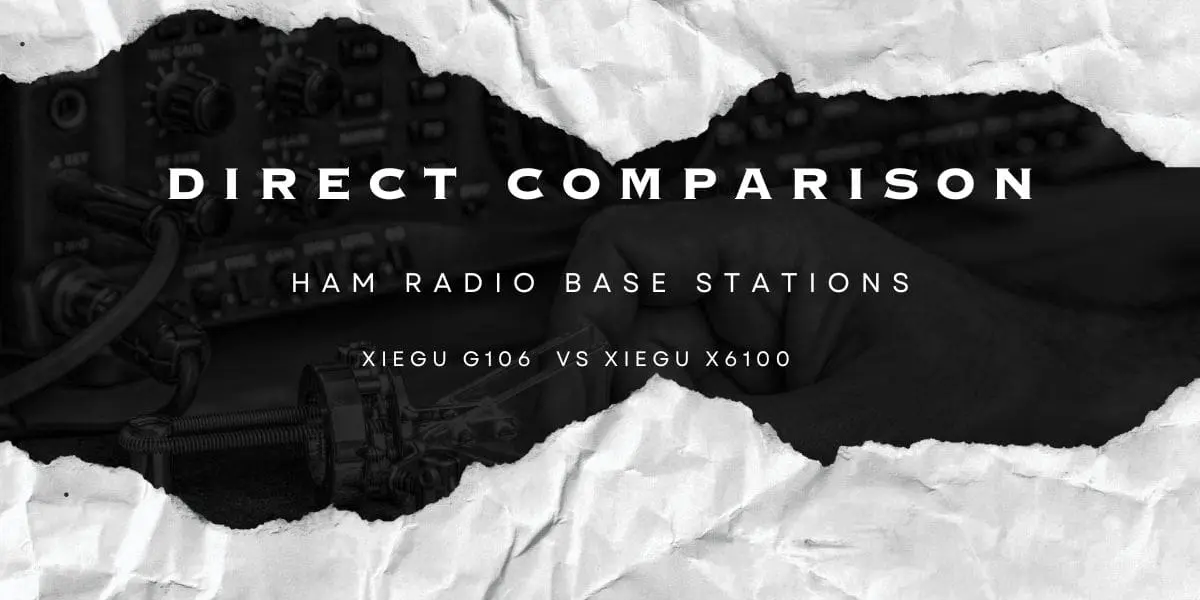Introduction
In the world of amateur radio, Xiegu has made a name for itself with its high-quality HF transceivers. Today, we’re comparing two popular models from Xiegu: the G106 and the X6100. Both are renowned for their performance, but they each have unique features that set them apart.
Meet the Xiegu G106
Xiegu G106: The Xiegu G106 is a powerful and versatile HF transceiver that brings the convenience of portability without compromising on performance. With its 5W power output and SDR infrastructure using 16bit CODEC sampling, it delivers superior performance in a compact package. The G106 supports three transmission modes – SSB, CW, and AM, and even allows for FM receive only, making it a perfect companion for local communications and FM broadcasts.
5W QRP Radio, SSB CW AM WFM, Support FT8
Meet the Xiegu X6100
Xiegu X6100: The Xiegu X6100 is a state-of-the-art HF transceiver that combines advanced technology with user-friendly design. With features like 10W high power for longer range communication and dual-band functionality, the X6100 is designed to meet the diverse needs of amateur radio enthusiasts. Whether you’re in an urban setting or exploring the great outdoors, the X6100 ensures reliable and efficient communication.
10W Full Mode SDR Radio Supports BT with 4" LCD Screen
Design and Build
The Xiegu G106 is a compact and robust transceiver, designed for durability and ease of use. Its small size makes it perfect for portable operations, while its sturdy build ensures it can withstand the rigors of outdoor use. On the other hand, the X6100, with its 4-inch large color screen, offers a high-resolution display that allows users to see all the important information at a glance.
Performance and Features
The G106 boasts a high-performance SDR infrastructure, providing excellent sensitivity and selectivity. It covers all HF amateur radio bands between 3.5 and 29.7MHz, ensuring a wide range of communication possibilities. The G106 also offers WFM broadcast receive coverage and continuous receive coverage across all HF frequencies.
In comparison, the X6100, with its software-defined radio (SDR) system, provides real-time information, completes complex operations, and processes data faster. It also offers a power upgrade from 5W to a maximum of 10W, allowing for greater range.
Connectivity and Control
The G106 can be connected to a computer for data communication modes, with the appropriate software installed. It also offers computer-based remote control via a CAT port, providing users with more flexibility and control.
The X6100, on the other hand, supports modern connection methods like mouse and keyboard control via Bluetooth, in addition to traditional connecting ports. This makes it a more versatile option in terms of connectivity.
5W QRP Radio, SSB CW AM WFM, Support FT8
10W Full Mode SDR Radio Supports BT with 4" LCD Screen
Warranty and Support
The G106 comes with a 1-year warranty, providing users with peace of mind. However, the X6100 offers an 18-month warranty, giving it an edge in terms of after-sales support. Both warranties become void if the radio’s hardware is modified.
Comparison Chart
| Feature | Xiegu G106 | Xiegu X6100 |
|---|---|---|
| Design | Compact and robust | Large 4-inch color screen |
| Performance | High-performance SDR infrastructure | Software-defined radio (SDR) system |
| Frequency Coverage | All HF amateur radio bands between 3.5 and 29.7MHz | All HF amateur radio bands |
| Power | Standard | Upgrade from 5W to a maximum of 10W |
| Connectivity | Computer-based remote control via a CAT port | Traditional connecting ports, mouse and keyboard control via Bluetooth |
| Warranty | 1-year | 18-month |
Pros and Cons List For Each
XIEGU G106 SDR HF TRANSCEIVER
Pros:
- Compact and robust design: Ideal for portable operations and can withstand outdoor use.
- High-performance SDR infrastructure: Provides excellent sensitivity and selectivity.
- Wide frequency coverage: Covers all HF amateur radio bands between 3.5 and 29.7MHz.
- Computer-based remote control: Offers more flexibility and control.
Cons:
- Limited power: Standard power output may limit range.
- Limited connectivity options: Lacks modern connection methods like Bluetooth.
- Shorter warranty period: Comes with a 1-year warranty, which is shorter than the X6100.
XIEGU X6100 HF TRANSCEIVER
Pros:
- Large 4-inch color screen: High-resolution display allows users to see all important information at a glance.
- Software-defined radio (SDR) system: Provides real-time information and processes data faster.
- Power upgrade: Allows for greater range with a maximum of 10W power output.
- Versatile connectivity options: Supports traditional connecting ports and modern methods like mouse and keyboard control via Bluetooth.
- Longer warranty period: Comes with an 18-month warranty, providing longer after-sales support.
Cons:
- Larger size: May not be as portable as the G106.
- More complex to operate: The additional features and options may require a steeper learning curve.
Other Options To Consider
- Yaesu FT-891: This is a compact, lightweight, and high-performance HF/50MHz transceiver. It’s known for its superior receiver performance, high power output, and a wide range of features including a built-in automatic antenna tuner.
- Icom IC-7300: This is a popular choice among amateur radio enthusiasts. It’s a high-performance, innovative HF transceiver with a compact design. It features a real-time spectrum scope and a high-resolution waterfall function.
- Kenwood TS-590SG: This is a high-performance HF/50MHz transceiver that offers superior reception and powerful audio. It features advanced IF DSP technology, a built-in automatic antenna tuner, and a USB port for easy PC connectivity.
- Elecraft KX3: This is a compact, all-mode, all-band transceiver that provides a wide range of operating modes including data (PSK31 and RTTY), SSB, CW, and more. It’s known for its excellent receiver performance and low power consumption, making it ideal for portable and field operations.
Remember, the best radio for you will depend on your specific needs, preferences, and budget. It’s always a good idea to compare different models and read reviews before making a decision.
Conclusion
In conclusion, both the Xiegu G106 and X6100 are excellent choices for amateur radio enthusiasts. The G106 stands out for its compact design and high-performance SDR infrastructure, while the X6100 shines with its large color screen and versatile connectivity options. Your choice between the two will depend on your specific needs and preferences.


































2 Responses
Hi I don’t see anything in spec sheets that says the Xiegu X6100 can transmit UHF/VHF
Tom, Thanks for bringing that to our attention. You’re absolutely correct. It is only HF, that was an error in our writing it up, and I have since corrected it. Thanks again.
Also, I just saw that you made a comment along time ago on an article about water purification that I somehow missed and never responded to. I’m posting that response now, but will paste it here to save you the troubl of navigating to find it.
You stated/asked:Hi Shane read your article on water purification we live at Rayburn lake. I believe it would be wise to have some type of filter or tablets to purify the lake water in case of long term water shortage. I’m interested in the Aqua tabs but not sure which filtration system to get would appreciate your recommendation.
RESPONSE: I completely agree you’ll want to have some long term solutions available. I’ll share my general approach for your consideration. I like aquatabs for my survival kits, but they are pretty expensive (IMO) if I’m looking for long term solutions. For that I rely on a few methods I’ll share. 1. I have a pond, so like you it would need treated. At the end of the day if you have the water you can resort (if needed) to SODIS (Solar Disinfection) method, but that’s not my goto. Additionally, Boiling is always a safe great option, but it takes, time effort and resources to do. As far as treatment I generally opt for Bleach (2 drops per Gallon(ish)) will do the trick, pre filter through cloth or some other filter type and you’ve got good water. I also keep and we actually use for our daily water a Berkey Filter. They are amazing. They are expensive, but great. you can buy thier filters and make your own homeade system using them as well. There are also alot of competitors out there now with then in the niche that may be worth considering, but I don’t have experience with them to speak to them (yet). Hopefully that answers you, and again truly sorry for missing the post!